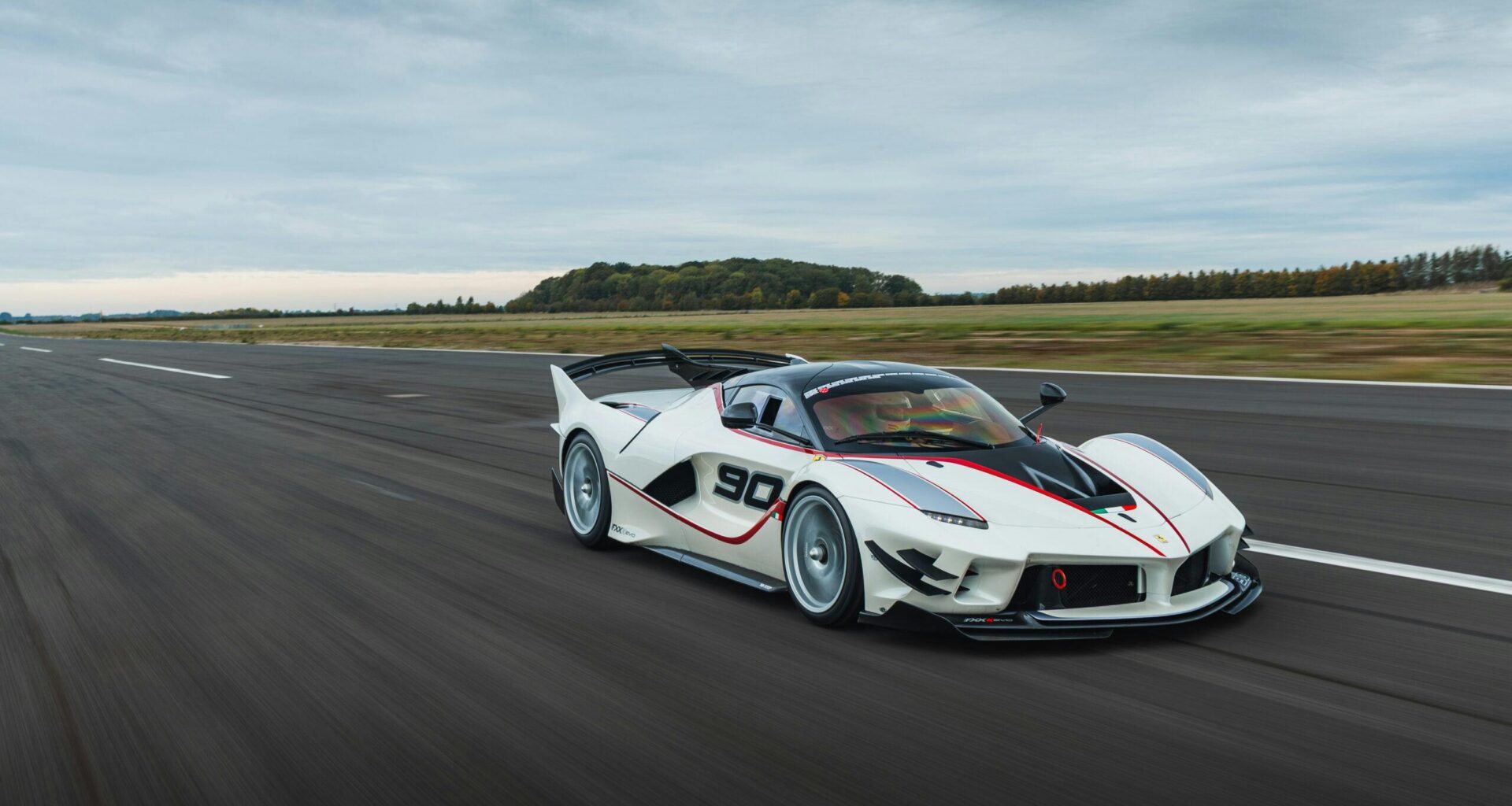Held on November 1 at the Peninsula London hotel on the edge of Hyde Park, this year’s RM Sotheby’s London auction finished with £23,703,910 ($31,149,308) in total sales. Track-focused modern hypercars took the top spots, with a 2015 Ferrari FXX-K Evo achieving £4,730,000 ($6,215,693) and an Aston Martin Valkyrie bringing £2,226,875 ($2,926,336). But there were plenty of old cars on offer as well, including one from 1900 and a dozen others built before 1910.
There were some soft prices across genres and price ranges, but most sold for reasonably healthy numbers within their estimates. A few surpassed expectations, and only a handful of the sale’s seven-figure lots failed to meet reserve. The Brits also love their number plates, and the highly coveted “1F” registration number sold for a staggering £905,000 ($1,189,261) at this sale.
Our colleague Chris Sharpe was on the ground at the London auction and provided valuable condition notes for the cars there. We look at the most interesting and significant ones in detail below.
Lot 124: 1908 Rolls-Royce 40/50 HP Silver Ghost Landaulette by Barker
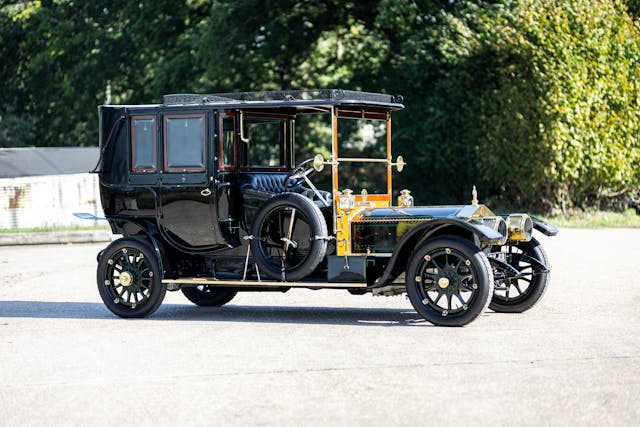 Neil Fraser/RM Sotheby’s
Neil Fraser/RM Sotheby’s
Sold for £331,250 ($435,296)
Chassis no. 60712. Black over black leather in front, green cloth in rear. Older restoration, #2 condition.
Equipment: RHD. 7428-cc/50hp L-head straight-six, four-speed, black painted wheels, single sidemount spare tire, landau bars. Interior trimmed in wood and green cord with matching brocade trim, also includes folding seats, small table, barware set, and window blinds.
Condition: Represented as one of the earliest extant Silver Ghosts, and retains much of its original coachwork. Originally delivered to Sir John Stewart-Clarke, the Lord Dundas, and later formerly owned by John Cuthill Sword and the Harrah’s Automobile Collection. Considered one of the most correct and authentic mechanical examples of the early 40/50 HP.
Great coachwork panels with equally good paint. The brass fittings, hinges, and details are incredible. The instruments have thick crystal lenses. The chauffeur’s speaking tube is charmingly quaint. The passenger compartment looks incredible, including the wood finishes. Presented in the style of an earlier carriage that clearly predates this car by a century or two. The standard of the whole motorcar is above anything else of the period. Restored decades ago, but still splendid.
Bottom line: Later known as the Silver Ghost, the 40/50 debuted in 1906 and was the automobile that earned Rolls-Royce its oft-repeated “best car in the world” tagline, first coined in Autocar magazine in 1907. Despite this one’s less-than-sporty coachwork, its originality and presentation are seriously impressive, and it wouldn’t be easy to come up with a better or more extravagant example of Edwardian era automotive luxury than this. Even so, its time on the auction block was shrug-worthy. The price is nearly £150K below its low estimate. This sale was heavy on early twentieth-century motorcars, so the Silver Ghost really could have done better.
Lot 141: 1954 Maserati A6GCS
 Tyler Houts
Tyler Houts
Sold for £1,748,750 ($2,298,032)
Chassis no. 2065; Engine no. 2065. Red over blue leather. Recent restoration, #2- condition.
Equipment: LHD. 1798-cc single overhead cam straight-six, four-speed, wire wheels, side exhaust, head fairing, woodrim steering wheel, wood shift knob.
Condition: One of two cars ordered in 1953 by French importer Garage Mirabeau in Paris, and originally finished in blue. Period race history from 1954-57 in Morocco and at Reims, Montlhéry, Goodwood, Scandinavia, Dundrod, and Castle Combe. Traded back to the factory in 1957. Later restored in the 1990s and has been a five-time Mille Miglia participant with the current owner. It comes with an October 2025 inspection report by Maserati historian Walter Bäumer. The body panels are slightly uneven, and the older paint has lots of fine swirl lines. The wheels look fresh. The grille doesn’t sit quite right. The interior has wonderful period controls, though the seats show plenty of use. The steering wheel, pedals, and shifter are pure ’50s class, and the blue Jaeger gauges are lovely.
Bottom line: Introduced in 1947, Maserati’s A6 was a remarkably versatile platform, birthing sleek sports cars and single seaters for the track along with voluptuous grand tourers for the road. As Maserati was still a very low-volume, primarily racing-oriented company, production of all types nevertheless numbered in the dozens. With the vast differences in configuration, coachwork, and race history between chassis, prices for Maseratis of this period vary greatly, but this one’s provenance and event eligibility pushed it to a strong result that topped its £1.45M high estimate.
Lot 116: 1904 Cadillac Model B Touring
 Neil Fraser/RM Sotheby’s
Neil Fraser/RM Sotheby’s
Sold for £109,250 ($143,565)
Engine no. 3251. Red over black leather. Older restoration, #3 condition.
Equipment: RHD. 1.6-liter/8.25hp “Little Hercules” single-cylinder engine, two-speed epicycle gearbox, bulb horn, button-tufted seats.
Condition: Delivered to its first owner in New York State in February 1904. Comes with a Vehicle Identification and Dating Certificate issued by the Veteran Car Club in 2011, two panniers, and a brass front light. Restored in the mid-2000s. Believed to have a replacement engine, and does have a replacement body. Has been a regular finisher in the London to Brighton Veteran Car Run since 2009, and sold with an entry into the 2025 event. Older paint with lots of fine swirls. Great brass work. Smart wheels and a wonderful basket-weaved umbrella tube holder.
Bottom line: Cadillac only started building cars in late 1902, and the Model B was the company’s second production model. It cost $900, and was available as either a runabout or a touring car. In a testament to how quickly automobile design was changing in the early years of the century, Cadillac had made it to Model F by the end of 1905.
As a collector piece, this car represents a good but not exceptional piece of early Caddy history. In terms of actually using it, though, the big appeal here is its eligibility for and entry into the London to Brighton Veteran Car Run. London to Brighton is one of the most popular motoring events in the world, but naturally cultivates exclusivity by excluding any motorcar not built before 1905. Cadillacs from just a few years after this one typically sell for well under six figures, so the L-to-B factor accounts for a huge chunk of the price here.
Lot 144: 2024 Aston Martin Valkyrie
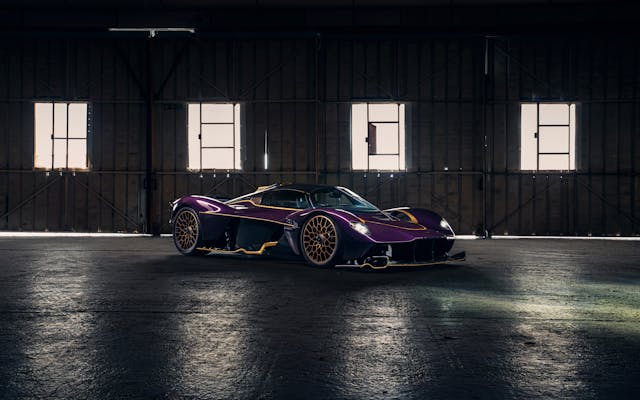 Alex Penfold/RM Sotheby’s
Alex Penfold/RM Sotheby’s
Sold for £2,226,875 ($2,926,336)
Chassis no. SCF4JRB47PGS70123. Purple-tinted carbon fiber with 24-carat gold leaf accents over purple Alcantara. Original, #1 condition.
Equipment: RHD. 6.5-liter/1160hp electric-assisted V-12, Ricardo seven-speed sequential gearbox, active aero.
Condition: One of 25 RHD cars from a limited run of 150 road-legal coupes. Co-designed by multiple Formula 1 championship-winning designer Adrian Newey. An as-new car with the odometer displaying a mere 112 miles at the time of cataloguing. Under manufacturer’s warranty until the end of January 2027. Built in bespoke “Anemos” (“wind” in Greek) configuration, which reportedly added £500,000 to the original list price of £2.5M and included this unique livery.
Bottom line: Powered by a Cosworth-developed V-12 assisted by a Rimac electric motor/battery pack, the Valkyrie is a joint project between Aston Martin, Red Bull, and others, and serves as Aston’s flagship track-focused model. It’s one of the quickest, most advanced things with four wheels and a number plate, and it better be given how much it costs.
The problem with bespoke top-shelf cars like this when they sell on to their second owner is that, if you happen to be that second owner, you’re often buying someone else’s build. And their tastes may not align with your own. This car’s purple and gold livery, for example, gets a lot of hype in the catalogue description, but all I can think of is a Crown Royal bag or an unmade sequel to Purple Rain. The bidders weren’t totally put off by it, but both RM Sotheby’s estimate and the final price discounted this low-production hypercar by a decent chunk.
Lot 133: 1939 SS 100 Jaguar 3½-Litre Roadster
 Tom Gidden/RM Sotheby’s
Tom Gidden/RM Sotheby’s
Sold for £169,625 ($222,904)
Chassis no. 39103; Engine no. M164E. White with black top over black leather. Unrestored original, #4+ condition.
Equipment: RHD. 3485-cc/125hp straight-six, four-speed, painted wire wheels, twin aero screens and a full folding windscreen, tools.
Condition: One of only 118 examples of the 3½-Litre built. Originally finished in Gunmetal over red, repainted multiple times in the 1950s and ’60s, and in single-family ownership since 1970. In dry storage for nearly 50 years. Powered by a period-correct SS 100 3½-litre replacement engine, fitted in 1955. Accompanied by a JDHT certificate, period “buff” logbook, 1969 issue of Motor magazine that featured the car, 1970s receipts, medical kit, Instruction Book, and SS Sales Brochure. Presented unrestored and very dusty. The front wing is dented. The interior is old and deteriorated. Ripe for restoration.
Bottom line: The SS Jaguar 100 (SS Cars switched its name officially to “Jaguar” in 1945) is among the more graceful British sports cars of the ’30s with its long hood, sweeping fenders, and massive Lucas headlights. Barely 300 2.5-liter and 3.5-liter cars were produced, so they are valuable, but not obscenely so, especially relative to other European cars of similar style and performance. This result is a solid balance between this car’s originality and completeness on one side, and the project-car condition and replacement engine on the other.
Lot 117: 1902 De Dion-Bouton Type L Vis-à-Vis Voiturette
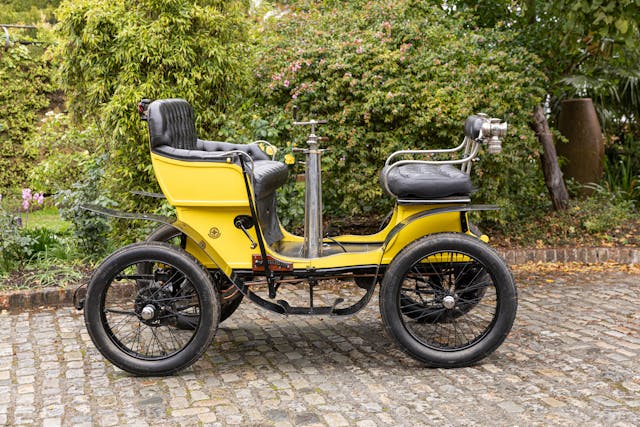 Simon Clay/RM Sotheby’s
Simon Clay/RM Sotheby’s
Sold for £52,900 ($69,516)
Chassis no. 235; Engine no. 10408. Yellow over black leather. Older restoration, #3+ condition.
Equipment: six-hp single-cylinder, two-speed constant-mesh transmission, painted wire wheels.
Condition: Unknown early history, but discovered in 1946 in a French barn, then went to Rhode Island where it stayed unrestored until 1994, when it sold at an estate sale. Sold again to the consignor in 2016, and it was subsequently restored for the first time. Documented by a VCC Dating Certificate, workshop invoices, and finisher certificates from the London to Brighton Veteran Car Run. It is a well-detailed vehicle, though it does show signs of use, and its restoration was clearly done for use and authenticity rather than the show field.
Bottom line: De Dion-Bouton was one of the most important and successful carmakers of the late 19th and early 20th centuries, with numerous innovations and, by pre-Model T standards, high-volume sales. This one’s Vis-à-Vis (“face-to-face”) seating is surely distracting, but also entertaining for puttering around with friends. Like the handful of other pre-1905 lots offered in London this year, this little yellow runabout’s eligibility for the Veteran Car Run counts for a lot in the eyes of buyers, and accounts for a good chunk of the price here.
Lot 137: 1937 Alfa Romeo 8C 2900 B Spider
 Tom Wood/RM Sotheby’s
Tom Wood/RM Sotheby’s
Sold for £2,817,500 ($3,702,477)
Chassis no. 412011; Engine no. 422031. Red over red leather. Older restoration, #2- condition.
Equipment: RHD. 2905-cc twin-supercharged straight-eight, four-speed, painted wire wheels.
Condition: Represented as one of 38 examples of the 8C 2900. A long-chassis model sold new in Germany and fitted with coachwork there. Received a 6C 2500 engine at some point and then bought by an American serving in West Germany in the ’50s. It remained an ongoing project between several owners until the late 2000s, when its full restoration was finished, complete with Spider bodywork in the style of Carrozzeria Alfa Romeo and Zagato. More refurbishment work, including an engine rebuild, was completed earlier this year.
Crisp paint and perfect panel fit. The engine bay is very clean. The cabin has the wonderful dog-leg gear selector and impressive controls, including a knurled thimble roller throttle pedal. Generally, the car’s lack of originality tells in its overall appearance. You see too many new panels, like the bulkhead. There are a lot of replacement components to this Alfa, but it’s still an 8C 2900 B, and that counts for a lot.
Bottom line: An engineering high point, the 8C 2900 was the ultimate iteration of Alfa’s series of eight-cylinder sports cars in the ’30s, and utilized a lot of technology developed in the company’s Grand Prix cars, so they were fast as well as gorgeous. Given how rare and desirable they are, there aren’t many comparable sales out there. In fact, only two have sold in recent memory. A Touring-bodied Lungo Spider sold for $19.8M in 2016 and again for $14M last year, while a Touring-bodied Berlinetta sold for €16.7M back in 2019. That shows how steeply discounted this car, with its replacement engine and body, was: It didn’t even meet its modest £3.5M estimate. For someone who wanted to experience the twin-supercharged 8C legend but had “only” seven figures to spend, this was something of a bargain.
Lot 149: 2015 McLaren P1 GTR
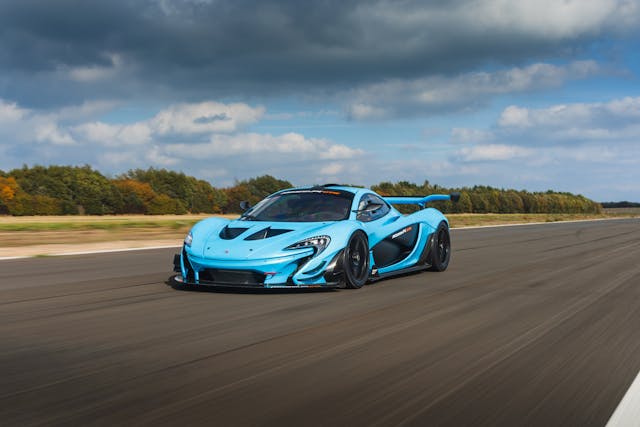 Charlie Brenninkmeijer/RM Sotheby’s
Charlie Brenninkmeijer/RM Sotheby’s
Sold for £1,310,000 ($1,721,471)
Chassis no. SBM12ABB5FW100014. Iridium Blue with satin black accents over black. Original, #2 condition.
Equipment: 3.8-liter/903hp twin-turbo V-8, seven-speed dual clutch semi-automatic, 1 McLaren E-Motor, IPAS (Instant Power Assist System), DRS (Drag Reduction System), and KERS (Kinetic Energy Recovery System), Pirelli P-Zero Corsa tyres, carbon-ceramic brakes, McLaren laptop.
Condition: Number 14 of just 58 built. Showing 6698 km (4162 miles), though that is track mileage at circuits including Mont Tremblant, Circuit of the Americas, Bahrain, and Silverstone. Regularly serviced by McLaren through its P1 GTR program. The paint finish is to race car standards, and the wheels have a small amount of rim scrape. The brakes and suspension are mint. A very cool thing, and would still be the quickest car at many a track day despite being 10 years old.
Bottom line: But an instant collectible, it ain’t. This car reportedly cost £2.376M new, and that doesn’t include all the miscellaneous track expenses, service bills, and two exterior wraps. Two other P1 GTRs have also sold for notably low results recently as well, including one for $1.435M in Miami earlier this year and another for $1.32M online a few weeks ago.
It appears the market prefers the standard P1 road car. It’s more common and less extreme than the GTR, but you wouldn’t exactly call a standard P1 tame, and you can actually use one on the road. Examples have sold for nearly or more than $2M, and the current #2 value in our price guide is $1.7M.
Lot 120: 1904 Turner-Miesse 10 HP Rear Entry Tonneau Steam Car
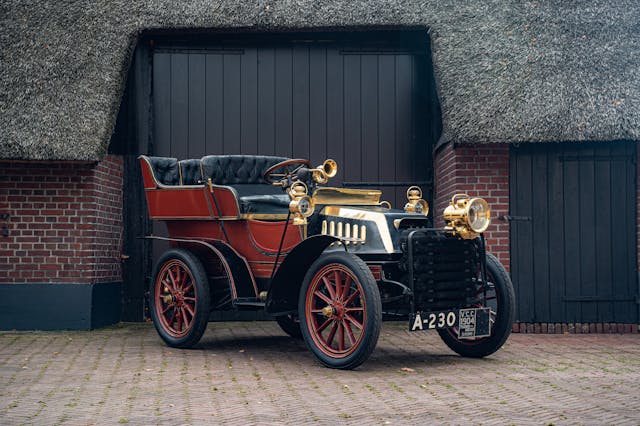 Willem Verstraten/RM Sotheby’s
Willem Verstraten/RM Sotheby’s
Sold for £109,250 ($143,565)
Chassis no. 256; Engine no. 256. Light brown and black over black leather. Older restoration, #3- condition.
Equipment: RHD. Horizontal three-cylinder engine with a closed crankcase, poppet valves and flash boiler, Lucas Duplex headlamp, kerosene lights.
Condition: A regular participant in the London to Brighton Veteran Car Run. Formerly owned by noted enthusiast Jack Croul and a class award winner in the 2014 Pebble Beach Concours d’Elegance. Aged paint but clean chassis and wheels. The wood steering wheel is cracked and glued back together. The bonnet panel appears to have been added later and looks wrong.
Bottom line: Belgian Jules Miesse started building steam-powered cars in 1896. He expanded to gasoline cars and trucks a few years later, and in 1902 a British company called Thomas Turner & Company started building Miesse’s steam cars under license, hence the name Turner-Miesse. It’s an obscure make, but any early steam car is interesting and a special experience. Again, the chance to use it with eligibility for London to Brighton is a huge selling point and made all the difference to the bidders.
Lot 163: 1985 Mercedes-Benz 190 E 2.3-16
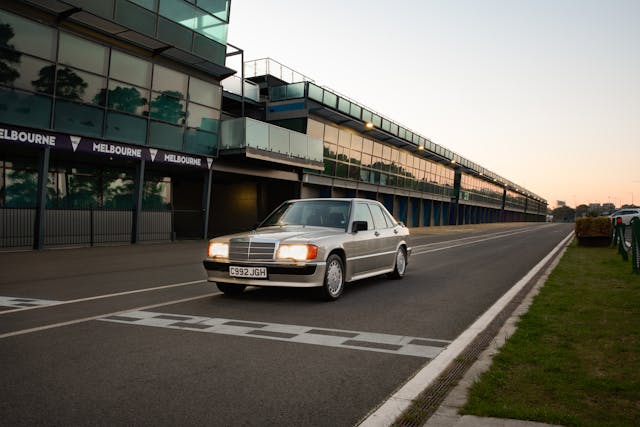 Darren Capp/RM Sotheby’s
Darren Capp/RM Sotheby’s
Sold for £230,000 ($302,243)
Chassis no. WDB2010342F152752. Smoke Silver Metallic over black leather. Visually maintained, largely original, #2 condition.
Equipment: RHD. 2299-cc/185hp Cosworth-tuned four-cylinder, five-speed, fire extinguisher, Becker Mexico stereo, sunroof, tool kit, first aid kit, books.
Condition: Bought new by Ayrton Senna and driven home from the Mercedes-Benz factory alongside fellow Brazilian Formula 1 driver Maurício Gugelmin. Senna’s desire for a 190 E 2.3-16 was motivated by his victory at the 1984 Nürburgring Race of Champions, where he drove a similar car to victory. He reportedly enjoyed the car for two years and racked up nearly 25,000 miles. Acquired in 1996 by the consigning owner, who took the car to Australia upon emigrating to the country in 2004. Engine bay signed by Niki Lauda at the 2016 Australian Grand Prix. Offered with original paperwork documenting Senna’s ownership. The car now shows over 154,000 miles but presents very well. There are windscreen wiper lines in the glass. The wheels are perfect. The slightly cloudy headlights are the only major sign of age.
Bottom line: Senna’s victory at the 1984 Race of Champions was a breakout performance for the F1 rookie. That he bought this car afterward is a testament to the impact that race had on him. He spent a significant amount of time driving it, too. This isn’t one of those celebrity-owned cars that somebody kept for a couple of months and traded in.
Naturally, given the Senna name, it sold for a massive premium that’s several times higher than what a normal 190E Cosworth in this condition is worth. But it could have brought more. It barely met its £220,000 estimate, and Niki Lauda’s actual race car from the ’84 Race of Champions sold for CHF308,750 ($363,621) in 2023. Later “Evo” versions of the 16-valve 190E have also sold for more than both.
Lot 150: 2015 Ferrari FXX-K Evo
 Charlie Brenninkmeijer/RM Sotheby’s
Charlie Brenninkmeijer/RM Sotheby’s
Sold for £4,730,000 ($6,215,693)
Chassis no. ZFF84DXX000212002. Bianco Italia paint with Rosso Fuoco and Argento accents over a Nero Alcantara. Original, #2 condition.
Equipment: 6.3-liter/1035hp electric-assisted V-12, seven-speed DCT, Evoluzione upgrade with redesigned rear brake intakes, fixed full-width dual rear wing on the active spoiler.
Condition: One of 60 examples built. Two private owners. Upgraded by Ferrari Corse Clienti to Evoluzione specifications, after which 61 kilometers have been covered. Currently shows 5722 km (3555 miles). There are a few minor marks to the PPF on the front wing edges, but that can be replaced easily enough. Otherwise, the car is perfect. The XX Programme’s most advanced V-12 model.
Bottom line: Started in 2005, Ferrari’s “XX” programs are a clever way to get even more money from customers, by having them buy experimental track cars and participate in research and development for future models and technologies through test driving. The first models were the Enzo-based FXX and the 599-based 599XX.
Heavily tweaked with more power and better aero, the FXX K was reportedly five seconds per lap faster around Ferrari’s Fiorano test track than the LaFerrari road car from which it was derived. Naturally, only a handful of these LaFerrari-based FXX Ks have sold at auction, but they were all close enough to this result. It was the most expensive car of the London sale, and fell right within its estimate range.
